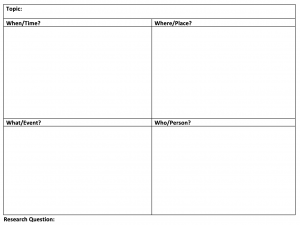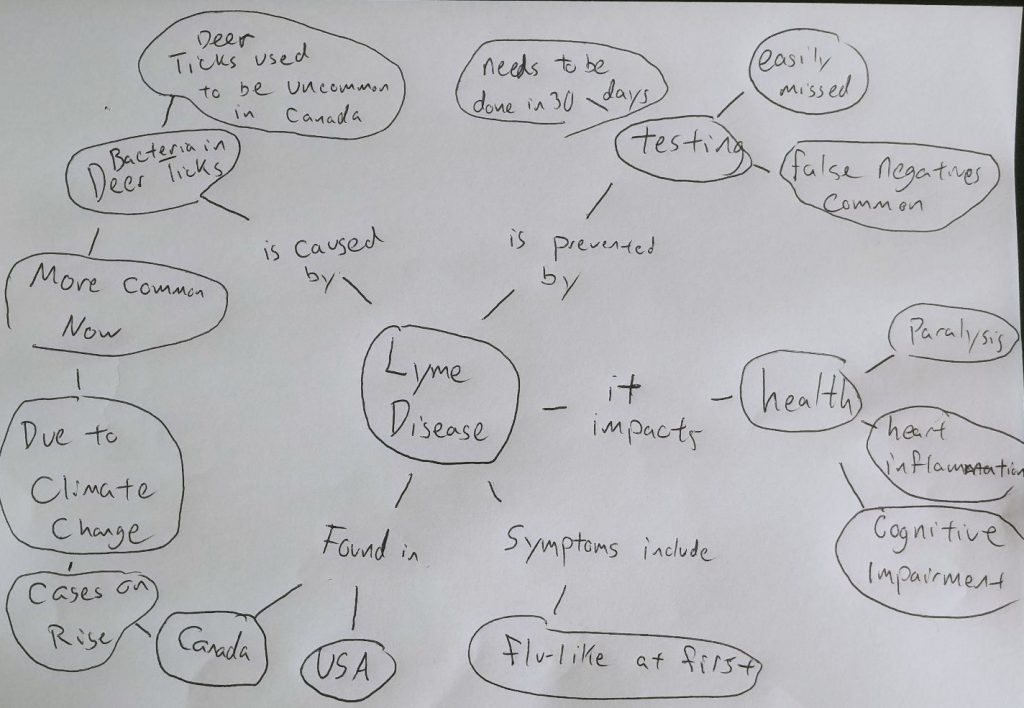Chapter 23: Report Planning and Choosing a Topic
Learning Objectives
By the end of this chapter, you should be able to:
- Compare different strategies for developing a focused topic and use one to start off your report.
- Develop a focused topic and research question for your formal written report.
Key Terms and Concepts
- iterative process
- scope
- focused topic
- research question
Writing as Process
As a technical student, you are already familiar with the design process. Whether you’re sketching a prototype or coming up with a pest management plan, most technical disciplines are already familiar with the cyclical nature of problem-solving.
A good example of this is the process used by the National Aeronautics and Space Administration (NASA). The image below highlights their process. Does anything stand out to you?

The process is cyclical! In RCM 200, we contend that technical communication follows a similar repeating pattern. In the context of report writing, there are three stages that must be followed and revisited. These are:
- Planning Your Message
- Producing a Draft
- Polishing the Draft
When looking at NASA’s design process, we can see some similarities to the plan – produce – polish process of report writing. Both processes are iterative, or a process for calculating a desired result by means of a repeated cycle of operations. If you were to use the NASA design process to write a report, it might look something like this:
- Ask: identify a research problem
- Imagine: brainstorm potential solution, research ideas, identify what research has already been done
- Plan: choose the report format, outline report sections, analyze secondary sources
- Create: write the report using the proper format
- Experiment: proofread and edit your report
- Improve: ask for feedback and make changes
We have obviously simplified the steps a bit by using three categories instead of six, but keep in mind that each part is essential to creating a strong report.
If you would like to see another example of a report writing process, look at the planning tool found in the the Assignment Planner from the U of S Library. This website also breaks up the writing process into stages.
Choosing Your Topic
Often, when you are first given a project, or even when you have already identified a topic you wish to research, the problem you are solving is fairly general and open-ended. While you can approach the problem in a variety of ways at this stage, you’ll need to do some work to decide which particular approach you will take. Most projects will require careful consideration of scope.
Who is your audience? What is your purpose? What are the limitations placed on what can be expected or achieved? What are the constraints you have to work within? All of these elements are rhetorical in nature and must be considered as you craft your message. This will be much easier once we come up with a focused topic.
A focused topic is what it sounds like: a report topic that is specific. You don’t want to your topic to be too broad or general, otherwise you will have a hard time creating your report because there will be too much information to cover.
For example, let’s say you want to do a report about climate change. You could argue that climate change is a specific topic within the environmental science field, but it’s still quite broad. To help you narrow your focus, it is best to spend some time determining what you already know, or what you want to know, about the topic you are considering. In this way, you will be able to figure out where gaps in your knowledge are and places you may need to focus in your research. You will then be able to develop a research question.
Exercise: Strategies for Developing a Focused Topic
What strategies have you used when developing topics for you past research papers? Did you just pick a topic you were kind of interested in and casually search the internet to find some relevant information? That’s certainly one way to do it, but that is a horribly inefficient approach! Using pre-writing strategies is a much better approach.
These strategies will help you figure out what you already know about a topic and what your knowledge gaps are. With this knowledge, you will be able to better utilize your research time.
The video below will walk you through one of these strategies:
Link to Original Video: tinyurl.com/developingtopic
 The video above highlights Questioning as one of the methods you can use to narrow the focus of your topic. Click on this link to download a copy of the “4-W” brainstorming table mentioned in the above video.
The video above highlights Questioning as one of the methods you can use to narrow the focus of your topic. Click on this link to download a copy of the “4-W” brainstorming table mentioned in the above video.
Here are some other topic brainstorming options you can try:
- Free–writing: write about the topic for 10 minutes straight without stopping or self-editing
- Mind-mapping or Concept-mapping: create a graphic organizer listing ideas and indicating how they are connected
- Questioning: who, what, where, when, why, how? What do I already know? What do I need to find out?
- Brainstorming: list all ideas without censoring or rejecting any, no matter how ridiculous they might seem at first.
Following one of these methods will help you narrow your focus. Clearly you won’t be able to solve whatever topic or issue you pick in one paper or project. And no reasonable instructor or employer would expect you to. The ultimate aim is to narrow your topic enough to provide a specific question to guide your research and identify key words and terminology related to your topic.
A good research question should be somewhat open ended; that is, the answer should not be a simple “yes” or “no.” The focus of your research question should allow you to provide a comprehensive answer that takes context into careful consideration.
Once you have your focused topic and a research question, you will ready to move on to using rhetoric to craft your message.
But before we do that, though, let’s take a look at the two students mentioned in the previous chapter—Mei (she/her) and Hamid (he/him)— and how they both approach their topics. Remember, Mei is picking a topic for her written formal report and Hamid is picking a topic for his oral persuasive speech.
Mei – Picking Her Topic (Formal Report)

When Mei first came to the University of Saskatchewan, she knew she wanted to be a scientist. She just didn’t know what type of scientist.
Originally, she was going to be a biologist, but that didn’t feel right, so she switched to chemistry after her first semester. That didn’t feel right either. It wasn’t until she took a physics course and learned about nuclear energy that she finally realized her life’s calling. She decided to become a nuclear physicist and started taking the appropriate classes.
When it is time to pick a topic for her RCM 200 formal report, Mei decides to write about nuclear energy, but she isn’t sure what to say. She thinks about her past discussions with people about the topic, and she remembers that those conversations often end with her being told that nuclear energy is dangerous and should be phased out entirely. Maybe she’ll write a report about that? However, to really get a sense of what she wants to say, she uses the Questioning method and generates the following form:
| Topic: Nuclear Energy | |
|---|---|
| When/Time? | Where/Place? |
the present (2021) and into the future |
Canada |
| What/Event? | Who/Person? |
using nuclear energy to combat climate change |
the general public |
Based off this exercise, Mei develops the following research question to help guide her research: How can nuclear energy help reduce the impacts of Climate Change?
Now that she has a focused topic and a research question to help guide her research!
Hamid – Picking His Topic (Persuasive Speech)
 A few months before taking RCM 200, Hamid went hiking with his family in Ontario. After a couple days, he noticed that he was developing a rash on his legs. He didn’t think much of it though since he assumed he had brushed his legs up against something poisonous on the hike. A few days after that, however, he started feeling fatigued. His started having general aches all over his body, and would occasionally get severe headaches. Thinking he might have the flu, Hamid went to see his doctor.
A few months before taking RCM 200, Hamid went hiking with his family in Ontario. After a couple days, he noticed that he was developing a rash on his legs. He didn’t think much of it though since he assumed he had brushed his legs up against something poisonous on the hike. A few days after that, however, he started feeling fatigued. His started having general aches all over his body, and would occasionally get severe headaches. Thinking he might have the flu, Hamid went to see his doctor.
The doctor told him that he did not have the flu: he had Lyme disease. Hamid was surprised because he thought Lyme disease only happened in the United States, not in Canada. The doctor informed him that deer ticks, which carry the disease, had been slowly migrating north to Canada over the years and the disease was becoming more common in Canada. The doctor also told Hamid that if he had not come in for treatment right away, the disease may have affected his central nervous system and potentially killed him.
When it was time to pick the topic for his RCM 200 persuasive speech, Hamid decided to speak about Lyme disease as his general topic. He decides to create a mind-map to help him decide what to speak about.

After reviewing his mindmap, Hamid realizes that he wants to learn more about the disease itself, and he also wants to be able to explain to people why they should be concerned about it as well. With both of those things in mind, he comes up with the following research question: Why is Lyme Disease becoming more prevalent in Canada and how what steps should Canadians take to make sure the don’t get it?
Hamid feels pretty good about the research focus he has come up with. But he also realizes that he may need to make adjustments along the way.
With their focused topics and research questions selected, Mei and Hamid can move on to the next step of the planning process: using rhetorical theory to craft their persuasive messages.
Key Takeaways
- Technical communication follows a repeating pattern where different stages are followed and revisited. For our course, we have three: (1) Planning your message, (2) Producing a draft, and (3) Polishing the draft. Following this iterative process will help you generate a more effective, polished message.
- The first thing you want to do is develop a focused topic. If you already have a general idea of the topic you want to use, that’s great. Start by using a pre-writing strategy to help you determine what you already know and what the gaps in your knowledge are.
- After you have your focused topic, write out a research question that you can answer through your research.
- Once you have both of those, you can move on to considering the scope of your project to get a sense of what the expectations and limitations are.
References
National Aeronautics and Space Administration. (2018). Engineering Design Process [Image]. NASA. https://www.nasa.gov/audience/foreducators/best/edp.html
Attributions
This chapter is adapted from A Guide to Technical Communications: Strategies & Applications (on ohiostate.pressbooks.pub) by Lynn Hall & Leah Wahlin. It is licensed under a Creative Commons Attribution-NonCommercial 4.0 International License
any communication on a specialized, technical topic
an account of your investigation into a subject, presented in a written document or oral presentation that has conventional formatting
an iterative process is a process for calculating a desired result by means of a repeated cycle of operations. An iterative process should be convergent, i.e., it should come closer to the desired result as the number of iterations increases.
elements you must consider that can impact the message you create and how it will be received. For example, the audience, the purpose of your message, and constraints you must work within
the receiver or receivers of a message
something that makes it difficult for your message to be received, such as beliefs, facts, interests, and motives. These can from both the rhetor and the audience
a specific topic for a written report or oral presentation that is neither too broad or too general.
a question that a research project sets out to answer
a report where you establish your credibility so the audience will accept the facts you present
a type of report where a person is using their voice to relay information

